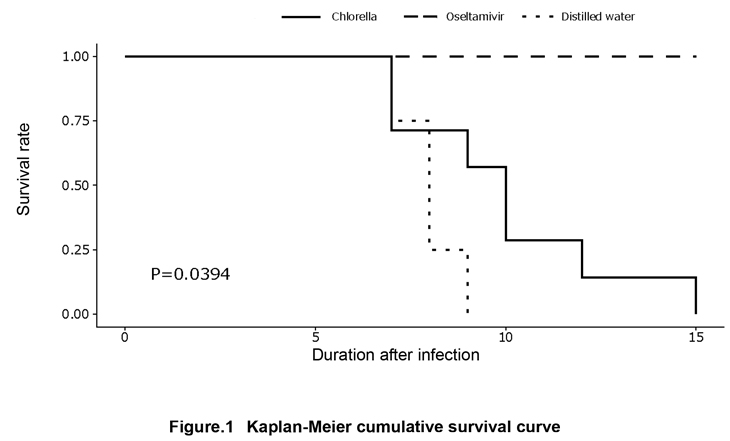- TOP
- List of reports
- Results from an animal study investigating the effect of Chlorella pyrenoidosa on
influenza virus infected mice have been published in a scientific journal.
Results from an animal study investigating the effect of Chlorella pyrenoidosa on influenza virus infected mice have been published in a scientific journal.
【Scientific information】
Research and Development Department, Sun Chlorella Corporation
Results from an animal study investigating the effect of Chlorella pyrenoidosa on influenza virus infected mice have been published in a scientific journal.
Japanese Journal of Complementary and Alternative Medicine. 2018, Vol.15
- Study objectives
- The effects of herbal medicines and nutritional support on influenza infection have been reported. As for Chlorella, its administration has been reported to increase resistance to infections with Listeria monocytogenes or Cytomegalovirus in animals; however, there are few reports on its effect on influenza infection. Therefore, we conducted a study on the effect of Chlorella on influenza virus infected mice.
- Study method
- The animals were BALB/cA mice (SPF, 6 weeks of age, female, CLEA Japan, Inc.); influenza viruses were strains of Influenza A virus (PR/8/34(H1N1)) adapted to mice kept at the Kitasato Institute for Life Sciences; and test substance was broken cell wall Chlorella powder of Sun Chlorella Corporation. The animals were allocated to either of a control group (distilled water), a positive control group (Tamiflu/oseltamivir), or Chlorella-administered group (8 mice per group). Chlorella was dissolved in distilled water to make a dose of 1000 mg/kg body weight and orally administered (0.1 mL/10 g body weight) from 1 week prior to virus infection up to 14 days after infection. One week after the start of administration, virus fluid was nasally inoculated (20 µL, 2 x LD50) following oral Chlorella to mice anesthetized with Nembutal (Sumitomo Dainippon Pharma Co., Ltd.). Tamiflu was orally administered (0.1 mL/10 g body weight) daily for 5 days from 4 hours before infection. Body weight, number of days survival, and survival rate were observed for 28 days from the start of administration.
- Results
- The result of weight measurements revealed that body weight began to decrease in all groups
approximately 3 days after virus infection. In the Tamiflu-administered group, a decrease in the
body weight tended to be moderate as compared with the other groups, but no significant
difference was noted. Deaths began to be observed after 1 week of infection except for the
Tamiflu-administered group. All animals died 10 days after infection in the distilled
water-administered group and 15 days after infection in the Chlorella-administered group. The
survival rate was determined using the Kaplan-Meier cumulative survival curve, and the distilled
water- and Chlorella-administered groups were assessed using the log-rank test (Fig. 1).
Consequently, the duration of survival of the Chlorella-administered group was significantly extended (P = 0.0394). In this study, the amount of virus infected with mice was enough to cause death from infection in all mice, and it is difficult to achieve a cure only by administration of immunostimulatory substances such as plant polysaccharide whose effect is relatively slow.
However, the administration of Chlorella significantly prolonged the duration of survival and increased the resistance to influenza virus infection, which means that the possibility of its clinical application was suggested as a material for responding to viral infection. It is expected that the detailed mechanism of direct effects of Chlorella on influenza virus and life prolongation of host is further elucidated in the future.

Details
- Journal name:
- Japanese Journal of Complementary and Alternative Medicine. 15 (1)
- Title:
- Effect of Chlorella pyrenoidosa on Influenza Virus Infected Mice
- Authors:
- Toru MIZOGUCHI, Hideo TAKEKOSHI
- Affiliation:
- Sun Chlorella Corporation





